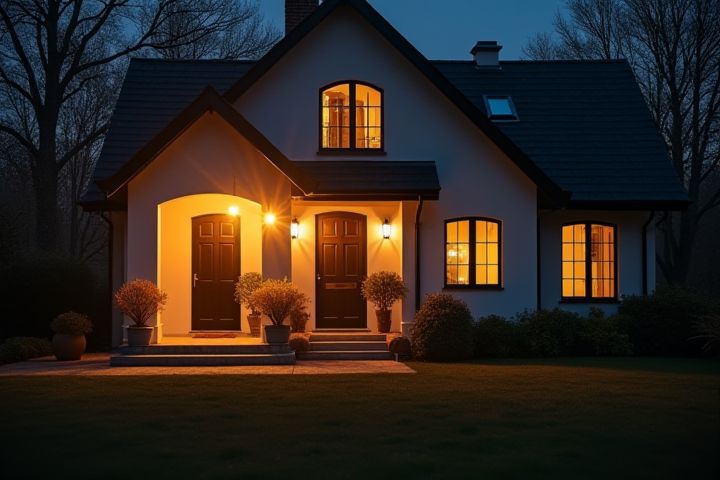
To effectively light a house, consider layering different types of lighting: ambient, task, and accent. Ambient lighting provides overall illumination, best achieved with ceiling fixtures and wall-mounted sconces that evenly distribute light throughout space. Task lighting focuses on specific areas, such as under-cabinet lights in kitchens or desk lamps in home offices for optimal functionality. Accent lighting enhances decor and highlights architectural features, using spotlights or decorative fixtures to draw attention to artwork or your favorite plants. Don't forget to incorporate dimmers for adjustable brightness, allowing you to create the perfect mood for any occasion in your home.
How To Light A House Effectively
Layered Lighting
Layered lighting is essential for creating a well-illuminated and inviting home. Start with ambient lighting, providing general illumination from sources such as ceiling fixtures and wall sconces, to ensure a comfortable level of brightness throughout your space. Incorporate task lighting, like table lamps and under-cabinet lights, to focus on specific areas for activities such as reading or cooking. Finally, enhance the atmosphere with accent lighting, using spotlights or decorative fixtures to highlight artwork or architectural features, transforming your home's aesthetic and functionality.
Natural Light Utilization
To optimize natural light in your home, consider using large windows or glass doors, which can increase daylight penetration by up to 50%. Position mirrors strategically to reflect sunlight into darker areas, enhancing brightness without additional energy costs. Light-colored walls and ceilings can amplify illumination, reflecting up to 90% of incoming natural light. Finally, decluttering windows and using sheer curtains will maximize your space's exposure to sunlight, reducing reliance on artificial lighting during daytime.
Task Lighting
Task lighting is essential for illuminating specific areas where activities such as reading, cooking, or studying occur. To effectively implement task lighting, choose fixtures that provide direct light without harsh glare, such as adjustable desk lamps or under-cabinet lights. Position these lights at appropriate angles to minimize shadows and enhance visibility on work surfaces. Consider using LED bulbs for energy efficiency and longevity, ensuring your lighting solution is both practical and environmentally friendly.
Ambient Lighting
Ambient lighting should provide a comfortable level of illumination throughout your home, typically between 100 to 300 lux for general living spaces. Opt for a combination of natural light and soft artificial sources like LED ceiling fixtures, which are energy-efficient and can last up to 25,000 hours. Consider using dimmer switches, allowing you to adjust the brightness according to the time of day or activity, enhancing the versatility of your lighting. Incorporating light-colored walls and reflective surfaces can also amplify ambient light, making your home feel more spacious and inviting.
Accent Lighting
Accent lighting enhances the ambiance of your home by drawing attention to specific features or areas. To create effective accent lighting, consider using fixtures with a brightness of 300 to 500 lumens to highlight artwork or architectural details. LED track lighting or adjustable wall sconces work well, providing versatility in focusing light where needed. By strategically placing these lighting sources, you can create a warm and inviting atmosphere, making your space feel more dynamic and visually interesting.
Energy-Efficient Bulbs
Energy-efficient bulbs, such as LED or CFL, can reduce your electricity consumption by up to 80% compared to traditional incandescent bulbs, significantly lowering your utility bills. When replacing bulbs, choose products with a high lumen output to maximize brightness while maintaining low wattage, ensuring optimal illumination in each room. Consider installing dimmer switches to adjust light levels according to your needs, which can further improve energy savings. To enhance your home's lighting efficiency, focus on natural light sources by strategically placing mirrors and utilizing light-colored wall paints, creating a brighter environment without increasing energy usage.
Dimmer Switches
Dimmer switches allow you to control the brightness of your lights, enhancing both ambiance and energy efficiency. Installing dimmer switches in each room can lead to a reduction in energy consumption by up to 20%, saving you money on electricity bills. For optimal performance, consider using LED bulbs compatible with dimmers, as they offer longer lifespans and lower heat output. Your ability to adjust lighting levels can also positively impact your mood and productivity, making dimmer switches a valuable addition to any home.
Light Placement
Effective light placement is crucial for creating a well-lit and inviting environment in your home. Aim to distribute lighting evenly across different areas using a combination of overhead fixtures, task lighting, and accent lights; for instance, a general overhead light combined with focused task lights in workspaces can enhance functionality. You should consider the height and direction of your light sources; installing dimmable fixtures at varying heights, such as sconces or pendants, can add depth and reduce glare. Additionally, utilizing natural light through windows and strategically placed mirrors can significantly amplify illumination while minimizing energy costs.
Color Temperature
When lighting your house, understanding color temperature is essential for creating the desired ambiance and functionality in each room. Measured in Kelvin (K), a lower color temperature around 2700K to 3000K produces a warm, cozy atmosphere, ideal for living areas like the living room or bedroom. In contrast, a cooler color temperature of 4000K to 5000K is well-suited for task-oriented spaces, such as kitchens or home offices, promoting alertness and concentration. You can enhance your home's aesthetic by selecting LED bulbs that offer a consistent color temperature to match your interior style and personal preferences.
Smart Lighting Systems
Smart lighting systems can enhance your home by providing efficient and customizable illumination, utilizing technologies like LED bulbs, which use 75% less energy than traditional incandescent bulbs. Features such as motion sensors and smart dimmers allow you to adjust brightness based on occupancy and time of day, potentially saving you up to 30% on energy costs. Apps enable remote control, allowing you to schedule lighting or create personalized scenes to match your activities or mood. Investing in smart lighting can increase your home's value and improve security by simulating occupancy when you're away.
